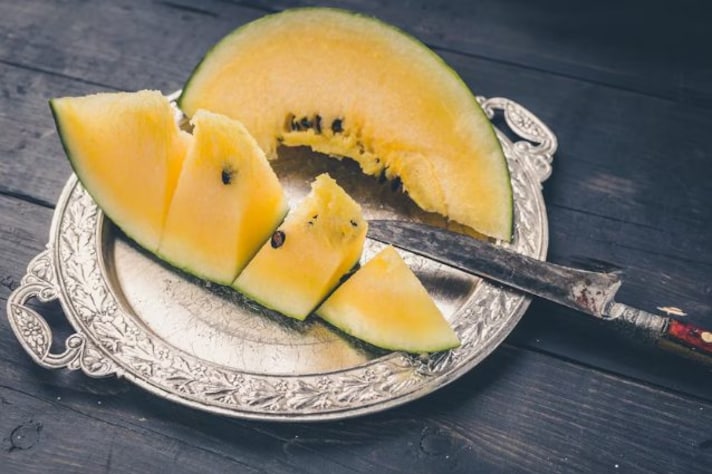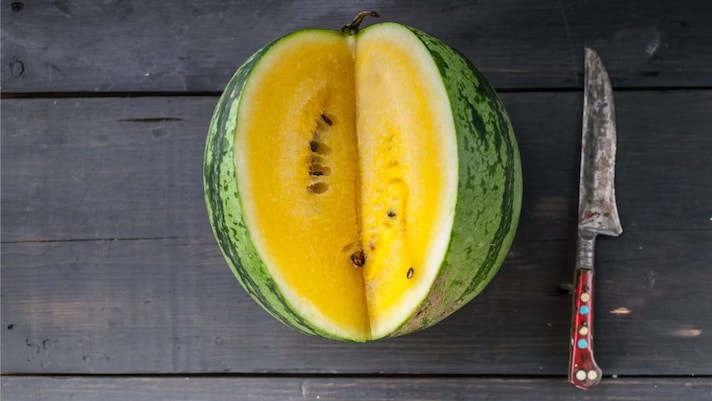
Yellow watermelon is a particular variety of "small" watermelon, the result of a completely natural and GMO-free Japanese botanical graft. Also known as coco-pineapple or Japanese watermelon, this curious fruit is a real concentrate of vitamins and beta-carotene; furthermore, it has an effect, if possible, even more thirst-quenching and refreshing than its more well-known cousin with red pulp.
Crunchy pulp, spotted skin and sugary flavor are the main characteristics of this fruit with numerous beneficial properties, which we find more and more often on the stalls of our markets. Where can we buy yellow watermelon? How is it different from the more well-known red watermelon and how can we use it in the kitchen? Let's find out together.
What is Yellow Watermelon?
At first glance it might seem like a small-grown red watermelon, but in reality, the yellow watermelon is a very particular variety, the result of a natural Japanese graft. Characterized by a thin, spotted skin and a crispier pulp than that of red watermelon, the yellow variety has a very particular flavor that oscillates between the sweetness of mango and the aftertaste of pineapple and prickly pear. The dimensions are relatively small and the weight does not exceed 6 kilograms: we are talking about a fruit rich in vitamins and mineral salts, harvested in the summer season, between June and August, just when we need thirst-quenching and refreshing foods.

Yellow Watermelon's Properties and Benefits
The nutritional profile of yellow watermelon is particularly interesting: composed of more than 95% water, it is the fruit that contains more than any other in nature, a characteristic that makes it incredibly thirst-quenching, diuretic and purifying. It is a real concentrate of beta-carotene and vitamin A, substances that in addition to giving the pulp its yellow color are useful for protecting the skin and defending the eyes and vision; excellent mineral salt content, among which potassium stands out, essential for fighting fatigue and ensuring correct muscle and nervous function. Yellow watermelon also has antioxidant and antibacterial effects thanks to vitamin C which strengthens and supports the immune system.

Yellow Vs. Red Watermelon
The most noticeable difference is the color of the flesh; red watermelons are the most common and have a vibrant red interior, while yellow watermelons feature a bright yellow or golden flesh. In terms of flavor, red watermelons tend to be sweeter with a more classic watermelon taste, while yellow watermelons often have a milder, honey-like sweetness with a hint of citrus. Nutritionally, both types are low in calories and rich in vitamins A and C, but red watermelons contain higher levels of lycopene, an antioxidant that gives them their red color. On the other hand, yellow watermelons are high in beta-carotene, which contributes to their yellow hue and provides additional benefits. Despite these differences, both varieties are refreshing and hydrating, making them popular summer fruits.
Where Can You Find It and How Can You Use it In The Kitchen?
The yellow watermelon can be grown between April and May in the ground, or between February and March in a seedbed and has a relatively short cycle that ends between June and August, the harvest period. You might be surprised to know that the yellow watermelon was born in Japan, but speaks Italian: this fruit has in fact found a perfect habitat, particularly in the Center and South, in Lazio, Sicily and Basilicata, where it is easy to find it on the stalls of local markets or directly from small producers. Production and distribution of the yellow watermelon are constantly growing and it is increasingly easy to buy it also on online platforms and in large-scale retail outlets.

How to use it in the kitchen? Yellow watermelon is a particularly fresh and thirst-quenching fruit, perfect as a simple after-dinner drink or as a summer snack, to be enjoyed on the beach. Furthermore, thanks to its very particular flavor, yellow watermelon can be enjoyed in sorbets and granitas and, for the more curious, also in rich and tasty mixed salads that it manages to embellish with a pleasant sweet and sour note.
;Resize,width=767;)
